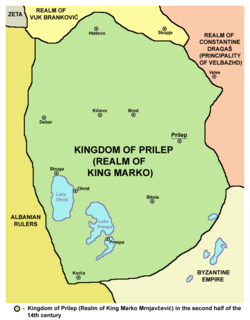
Back Прылепскае каралеўства Byelorussian Прилепско кралство Bulgarian Prilepské panství Czech Ηγεμονία του Πρίλεπ Greek Reino de Prilep Spanish Prilepi Kuningriik Estonian Signoria di Prilep Italian პრილეპის სამეფო Georgian Prilepo karalystė Lithuanian Прилепско Кралство Macedonian
Realm of King Marko | |||||||||||
|---|---|---|---|---|---|---|---|---|---|---|---|
| 1371–1395 | |||||||||||
 Medieval Realm of King Marko | |||||||||||
| Capital | Prilep | ||||||||||
| Religion | Eastern Orthodox Christianity | ||||||||||
| Government | Kingdom | ||||||||||
| King | |||||||||||
• 1371–1395 | King Marko (only) | ||||||||||
| Historical era | Medieval | ||||||||||
• Marko's inheritance | September 26, 1371 1371 | ||||||||||
• Subjugation by Bayezid I | 1395 | ||||||||||
| |||||||||||
| Today part of | |||||||||||
The Lordship of Prilep (Serbian: Господство Прилепа, romanized: Gospodstvo Prilepa), also known as the Realm of King Marko (Serbian: Област краља Марка, romanized: Oblast kralja Marka) or the Kingdom of Prilep (Serbian: Прилепско краљевство, romanized: Prilepsko kraljevstvo; Macedonian: Прилепско Кралство, romanized: Prilepsko Kralstvo; Bulgarian: Прилепско кралство, romanized: Prilepsko kralstvo; literally: 'Prilep Kingdom'), was one of the successor-states of the Serbian Empire, covering mainly the southern regions of the former empire, corresponding to western parts of present-day North Macedonia. Its central region of Pelagonia, with the city of Prilep, was held by lord Vukašin Mrnjavčević, who in 1365 became Serbian king and co-ruler of Serbian emperor Stefan Uroš V (1355–1371). After king Vukašin died at the Battle of Maritsa in 1371,[1] the realm was obtained by his son and designated successor (rex iunior) Marko Mrnjavčević, who took the title of Serbian king. At that time, capital cities of the Serbian realm were Skopje and Prizren,[2] but during the following years king Marko lost effective control over those regions, and moved his residence to Prilep. He ruled there until his death in the Battle of Rovine in 1395.[3] By the end of the same year, the Realm of late King Marko was conquered by the Ottoman Empire.
- ^ Ostrogorsky 1956, p. 481.
- ^ Gavrilović 2001, p. 146.
- ^ Ćirković 2004, p. 86.

